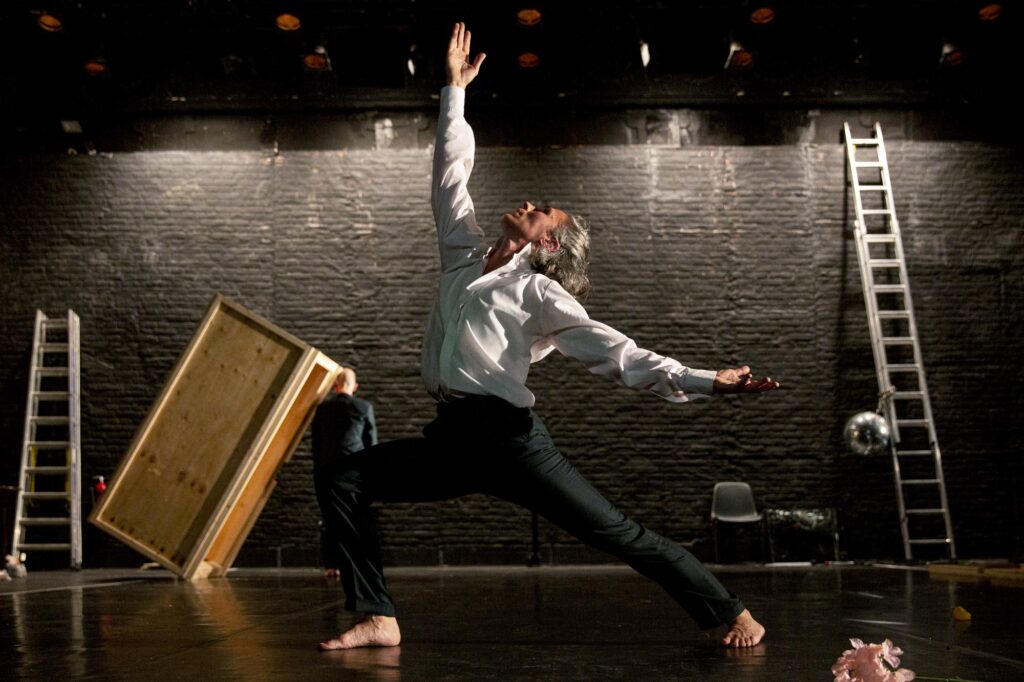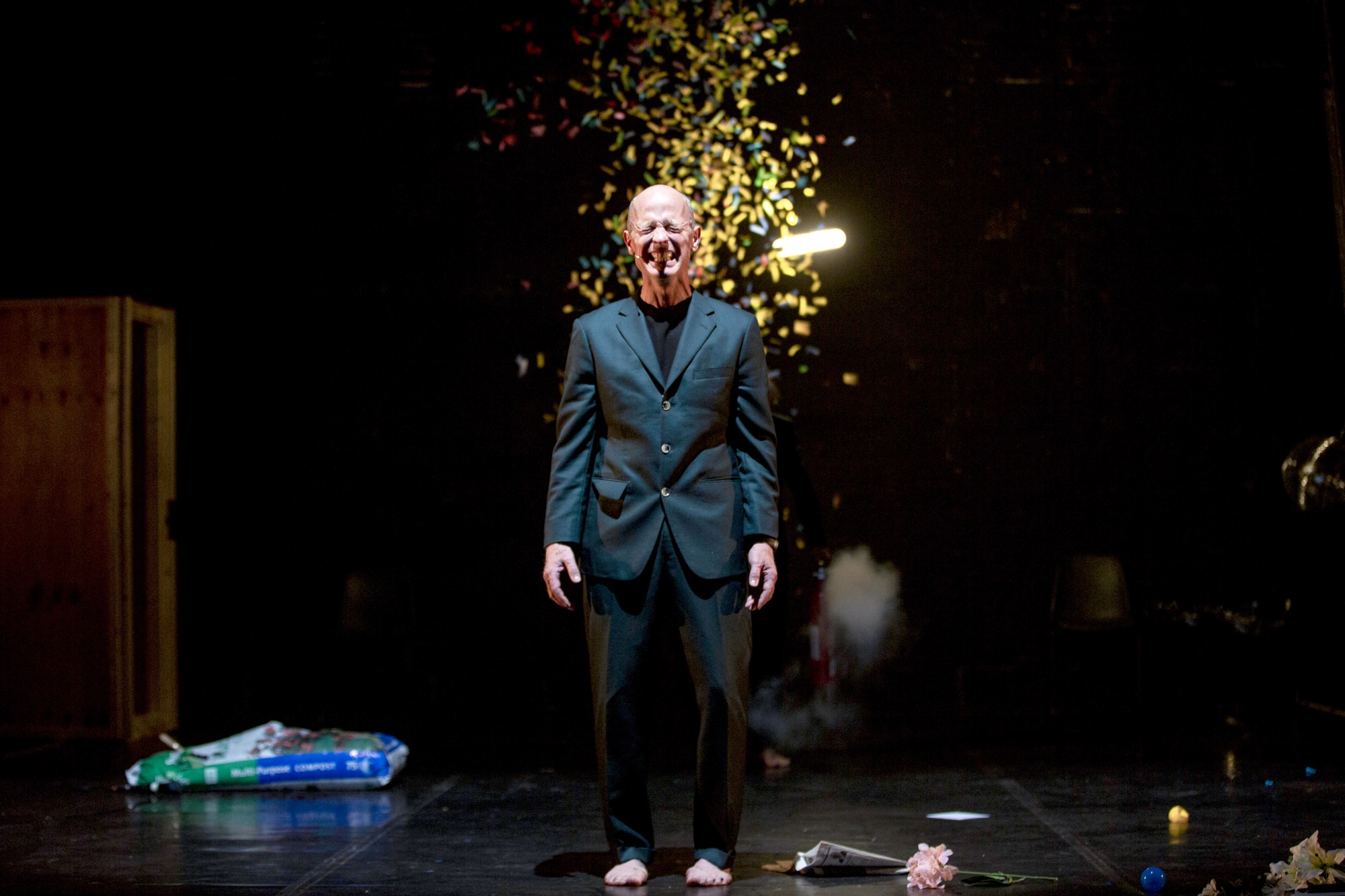Words by Bengi-Sue Sirin.
No one tells stories quite like the Irish, and choreographer/dancer/creative extraordinaire Michael Keegan-Dolan certainly puts paid to that. How to Be a Dancer in Seventy-Two Thousand Easy Lessons is the telling of a story of a life and all its complications, inevitably – through and even despite it all – leading to becoming a dancer. It is quite unlike any lesson I’ve sat through before; far more alive and humorous and cathartic. Totally worthy of the ovation of about seventy-two thousand volleys of applause!
How to Be a Dancer opens intriguingly. Keegan-Dolan and his longtime collaborator and partner, Rachel Poirier, sort of charge onto the stage in smart clothes and high spirits. Poirier headed to the prop in the centre, a large wooden cuboid that looked like a freshly-sawed coffin. After seemingly opening it with a drill, She began removing things from it, all sorts of random bric-a-brac, including in no particular order chairs, a bicycle, a disco ball, a dartboard, a bouquet of flowers, a rugby ball and my favourite, a balloon, which floated in its newfound freedom to the ceiling of the theatre. The concept of a time capsule came to mind; the unpacking of a life (quite literally); the examination of the past; the unearthing of a history.
This theme continued as Keegan-Dolan began an anecdote. “I met a man in Guatemala…”, he told us. I won’t ruin the pleasure of hearing said anecdote for potential future audience-goers but I will say that there was an egg involved, it was kind of magic realist and bizarre and strange, and it made us all smile. Something that happened throughout his telling was that Poirier brought segments of it to life, allowing the physical elements to be seen. This one-speaking, one-animating dynamic continued throughout the piece and it worked really beautifully.
My favourite instance was the “using-a-jockstrap-for-the-first-time” anecdote. Again, no spoilers; but I will say that Poirier’s hand movements and placements gave me, a woman, a very clear idea of how Keegan-Dolan, a man, felt when he first put on a jockstrap. The word that came to mind was indeed strapped!!
Another running strand through How to Be a Dancer is music. Music is deeply central – as shown in the constant presence of an old school boombox, carted around the stage. Keegan-Dolan has, in my opinion, excellent music taste. I would love to listen to his Desert Island Discs playlist (Lauren Laverne, are you listening??) And much like Desert Island Discs, every choice made sense in the narrative of his life. What song could follow an anecdote about homophobia and bullying and fear? ‘Psycho Killer’ by Talking Heads, of course! And what tune goes hand in hand with a story about being ill-equipped for sport and consequently drawn to dancing? ‘Men Without Hats’ The Safety Dance, “We can dance if we want to!”
And the lynchpin song, the one that features in the most gripping vignette of How to Be a Dancer…? Ravel’s Bolero; THE WHOLE THING. Bolero is a gorgeous piece of music, a total odyssey of buildup and anticipation – and god is the ending worth the wait. Much like, I suspect we are encouraged to read into it, Keegan-Dolan’s feelings upon finally being a dancer. His choice to have Poirier dance the whole song through is at odds with the snippety nature of the other songs and stories; it forces us, and her, to be present with the music, and so we see the pure immersion of the self in the dancing. Dancing is about the journey and the destination – the Bolero scene is the perfect illustration of that.

I think it is important to note that a day or so before opening night, Keegan-Dolan announced on social media that he is cutting ties with Sadlers Wells due to their ongoing affiliation with Barclays, itself reportedly implicit in the Palestinian genocide. His severing of the relationship is a show of solidarity with the Free Palestine movement. As we see with Kneecap and numerous other Irish performers, there is a strong show of support for another nation that many would argue is undergoing systemic oppression. As How to Be a Dancer shows us, history certainly repeats itself.
I noticed several audience members wearing Palestine badges on the way in; something buzzed in the air. This political element underpinned the show, giving extra force to the “You. Fuckin. PADDY!!” sequence. It is rare that I’ve felt like I’ve been at an important moment in the timeline of dance, and this was one. DAJ supports Keegan-Dolan’s brave decision.
And for all the joy and humour and lightness, there is plenty of tension. A recurring motif is the dangerously close call of head impact caused by Poirier swinging a microphone round and round by the lead. She does this as Keegan-Dolan is narrating particularly heavy moments. It is a strong visual reminder of how perilous living your truth can be, more prescient now than ever. This motif is utilised in a marvellously climactic way at the end of the show – gasp-inducing and gorgeous. The time capsule unpacked; the balloons of memories blown away. How to Be a Dancer is a confetti cannon of a show; at once violent, explosive, yet also joyful, humorous, and just plain super to watch.
